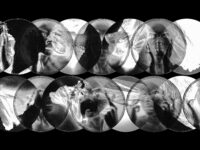
Minstrel Kuik: She who has no self
6.4.20
This essay by Alison Eggleton, Curator, Horsham Regional Art Gallery, was originally published in the catalogue to accompany the exhibition Minstrel Kuik: She who has no self, scheduled to take place from 15 February to 10 May 2020.
Wrapping the cover of this catalogue is an image of She who has no self from Minstrel Kuik’s photographic installation. Framed by a series of overlapping circles, an Asian women’s face appears, her hands to the corners of her eyes. She is just visible, appearing and disappearing in a shifting depth of field. Like a film reel, in a sequence of images, she slowly changes the position of her gesture. The woman is the artist performing for the camera, imitating a “Chinese woman”.
In this, as in many of Kuik’s works, she plays with the construction of the photographic image, its conception and perception, to question the periphery of cultural identity, conformity, gender and the politics of place. Interested in how the act of seeing is shaped by society, (1) Kuik explores photography’s equivocal relationship to truth, to understand the self amongst the complexities of modern life in Malaysia.
Within the complex digital montage of She who has no self, Kuik’s figure sits in tension with two interconnected relationships; family and nationhood. The image of a hibiscus flower, Kuik originally picked from her balcony then dried, appears skeletal in forensic detail. This Chinese botanical specimen, ironically the national flower of Malaysia and found growing abundantly in the Kampongs (Malay villages). Here it symbolizes the dual meaning of the flower as the individual’s vanity and cultural integration into the national narrative, linked by how one wishes to be seen. The image of the round mirror, reflects the malaise of the individual‘s connection to national narratives, which is characterised by a constructed national identity that attempts to unify the multi ethic society with the broad brush stroke of one identity. (2)
This major body of work originally made in 2014, is now reworked and retitled for this exhibition. The images are turned from a positive to a negative, from pink tones to black and white, the scale enlarged and the surface grainy. These recent manipulations reflect her process of making over time, as she rethinks material relations, and repositions the body and her culturally gendered experiences within these relationship dynamics.
The use of the word ‘self’ is a carefully chosen. It surpasses the construction of the individual so well known in the west. The individual is one that is not separate from society, but governed by societal forces, in a triangle of drama, between family and nation. (3) Born in Malaysia of Chinese ancestry, Kuik negotiates these tension daily.
‘The non-Malays (Chinese), no matter how deep their family roots might go, are … pendatang (recent immigrants) and only guests in Malaysia.’ (4)
For Kuik ‘she’ not only references woman, it is a place, an object, a group of people or simply a state of mind. The title She who has no self, Kuik borrows from the Buddhist deity Nairatyma. Applied here poetically through the images of the artist’s figure, the flower and the mirror, the ‘self’ dissolves into a state of impermanence beyond the controls of society.
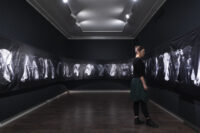
Minstrel Kuik: She who has no self at Horsham Regional Art Gallery. Documentation by Baillie Farely
Printed on fabric and over 18 metres in length, the work internally wraps the physical space of the gallery, enclosing the viewer. Kuik’s installation makes reference to the fantastical Qing Dynasty novel, Flowers in the Mirror. As the mythical story suggest, She who as no self becomes a contemporary pavilion of mirrors, where the digital manipulation and layering of images reinforces the notion of a reality abound with perception and illusion.
In an early discussion with Kuik about truth, and truth in photography, she quoted philosopher Martin Heidegger, from the 1930 book On the Essence of Truth:
“Truth” is not a feature of correct propositions which are asserted of an “object” by a human “subject” and then are “valid” somewhere, in what sphere we know not. Rather, truth is disclosure of beings through which an openness essentially unfolds.
Kuik does not begin making work knowing the outcome, rather, embedded within the construction of her photographic images is an awareness of her surroundings, integral to place, and an understanding of the powerful role photography can play in representation and identity politics. This is a conscious response to the political messaging and photographic imagery of national unity amid the lived experience of racial inequality in Malaysia. Negotiating the tensions of different ideologies and social bounds is an everyday occurrence. Place based photographic practice grounds her image making (5) giving a sense of self to counter the State driven rhetoric promoting racial harmony. The photographic montage is one way Kuik addresses the constant slippage from reality in this master narrative.
Kuik’s approach to the medium of photography does not fit neatly into any one style or technique. (6) It is a tool from which she works with an openness, shifting between the vernacular and the performative; between the ‘snapshot’ documentary and highly constructed assemblage. This forms a distinctive repertory of images from which she works and reworks. Her extensive reading, thinking, making and revisiting is traceable and reflective through digital manipulation and text.
Through this photographic archive, the index (7) of time becomes a reoccurring point of dialogue. Kuik responds to each exhibition invitation as an opportunity to look into her archive, to rework images with the physical space of the gallery in mind. Transforming images into negatives is another way in which she traces time and personal history. Through the digital negative Kuik also connects to the materiality of the mid tone grey she explores in her drawing practice. The artist’s disruption of these records through the act of retitling and digital manipulation directly challenges the notion of truth while tracing her shifting concerns over time.
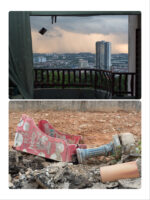
Minstrel Kuik, The Suburbs from the series Mer.rily Mer.rily Merily Mer.rly Part 2, 2013-17, C-Type print on paper. Courtesy of the artist and Richard Koh Fine Art, Kuala Lumpur.
In this exhibition is also the series Mer.rly Mer.rly Mer.rly Mer.rly Part 1 & 2, a major body of photography shown for the first time in its entirety. Working from an archive of images over a decade, Kuik distinctively constructs 43 photographic pairs. Along the wall of the gallery is an image of young girls, triplets, perched on a couch above an image of pomegranate seeds held in the palm of the artist’s hand. On another wall an image of a mango hanging wrapped in plastic, above an image of women, one with a baby in her arms, greeting each other in the street. On another, a card of primary colours blue, yellow and red held at a window, sitting above the image of the artist’s long head of hair as she holds a miniature skeleton doll.
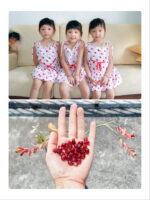
Minstrel Kuik, Triplets from the series Mer.rily Mer.rily Merily Mer.rly Part 1, 2008-12, C-Type print on paper. Courtesy of the artist and Richard Koh Fine Art, Kuala Lumpur.
This series was first conceived from photographs Kuik shot on her return to Malaysia after 12 years spent overseas. At that time she preferred to pick up the camera than cook in the kitchen with the female members of her family. (8) In vivid colour, observations of everyday ritual and intergenerational bonds (her niece, her mother) and surroundings of her village in Perak then extended to the broader urban spaces of Kuala Lumpur, the street, foreign workers and construction sites in the city.
A combination of documentary and still life compositions reveal sections of the artist’s body in the photographic frame as she balances the act of performing with the act of capturing the scene. Appearing at first as diary like snapshots of everyday life, they are imbued with metaphor; hair as an important female cultural currency, the mango a ubiquitous fruit to Malaysia, blood as female fertility, girl as childhood self, fish as the body, political leaders as the father and foreign worker as ‘other’.

Minstrel Kuik, A Rare Encounter from the series Mer.rily Mer.rily Mer.rly Mer.rly, 2008-12, C-Type print on paper. Courtesy of the artist and Richard Koh Fine Art, Kuala Lumpur.
With the camera’s view always looking out to the surroundings, we do not see her face nor is she pictured with family members, Kuik brings to our attention her absence from these images. It is in this rhythmic narrative of the public and the private, that the artist locates the proximity of our relationship to family and the family album while grappling with her own sense of belonging amongst the gendered realities of everyday life in Malaysia.
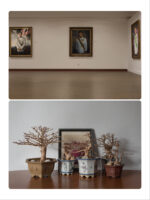
Minstrel Kuik, Hall of Fame from the series Mer.rily Mer.rily Merily Mer.rly Part 2, 2013-17, C-Type print on paper. Courtesy of the artist and Richard Koh Fine Art, Kuala Lumpur.
Inspired by philosophical discussion in ‘the everyday’ while studying in France, Kuik wanted to create the archetypical Chinese Malaysian family album. One that represented her ‘hometown’ (9) but as an adult self, she wondered if this was even possible. Through the aesthetics of the family album she questions the notion of loyalty in family, who she is as a women, daughter, aunty, sister and how she fits in.
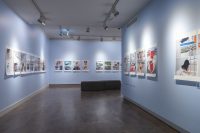
Minstrel Kuik: She who has no self at Horsham Regional Art Gallery. Documentation by Baillie Farely
Each work Mer.rly Mer.rly Mer.rly Mer.rly Part 1 & 2 is titled, the words bridging the images in the photographic quasi- pair. Finding the status quo within the pairs reflects her philosophy of living; “an artist is never separate from society” (10) family or nation. Kuik finds patterns in the power structure of the nation and within family which she explores through image making. (11)
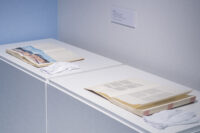
Minstrel Kuik : She who has no self exhibition at Horsham Regional Art Gallery. Documentation by Baillie Farely
Marking a similar period of time in her practice, the Kuala Lumpur Trilogy 2007/17, a series of 3 handmade photobooks serve as an extension of her use of the photographic archive. Through photographic essay narratives and automatic writing she maps place and thought.
‘I was born a woman, female, l was born Chinese, l was born in Malaysia, and in this body, my art practice explores these living conditions’. (12)
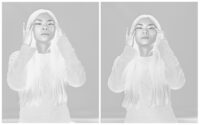
Minstrel Kuik Mimic la chinoise 2005-19. C-Type print on fabric. Courtesy of the artist and Richard Koh Fine Art, Kuala Lumpur.
The exhibition begins and ends with the double images of Mimic la chinoise, which float on fabric in pale grey tones. Similar to the performative images embedded in the layering of She who has no self, the figures powerfully play with the masquerade, while taking her body to the limits of cultural conformity. In conversation with the artist in January 2020, Kuik admitted that until she moved overseas to France she was unaware of being ‘Chinese’ beyond the bounds of Malaysia. Originally made in 2004-05, while studying photography in France, Mimic la chinoise confronts Kuik’s own experience of ‘otherness’ under the Western male gaze.
The word mimic, is a direct references to Jeff Wall’s iconic photograph Mimic from 1982, in which a white man makes a slant-eye gesture at an Asian man. Kuik’s double image looks directly at her imaginary audience, bringing into focus the individual self while subverting the East-West binary. (13) In this work, the artist postures the historically open ended appearance and disappearance of the gendered experience. It is a powerful reminder of how cultural conformity is still perpetuated through stereotypes and how they can sometimes play out in daily life.
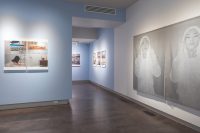
Minstrel Kuik : She who has no self exhibition at Horsham Regional Art Gallery. Documentation by Baillie Farely
Through the language of photography and image making Kuik reflects on the trajectory of her lived experience. Her process brings to our attention the construction of images and photography’s capacity to be a medium of record while questioning the act of seeing.
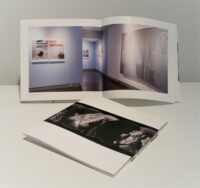
Minstrel Kuik: She who has no self, curated by Alison Eggleton, is presented at Horsham Regional Art Gallery as part of PHOTO 2020 International Festival of Photography. A 32 page printed catalogue to accompany the exhibition was made possible through the support of the Gordon Darling Foundation and includes essays by Alison Eggleton and Associate Professor Yeoh Seng Guan, urban anthropologist, Monash University, Kuala Lumpur. Contact Horsham Regional Art Gallery to purchase catalogue for $10, including postage and handling.
1, 6, 11 & 13 Zhuang Wubin (2016) Photography in Southeast Asia, a Survey 2016, NUS Press pages 41-47
2 Eric C. Thompson (2007) Unsettling Absences: Urbanism in Rural Malaysia, NUS Press, page 21
4 James Chin (2009) The Malaysian Chinese Dilemma: The Never Ending Policy (NEP), page 174
5 From artist’s email conversation to Racheal Ciesla, Photo2020 16 December 2019
7 Melissa Miles (2016) Rephotography and the Era of Witness, photographies 9:1, page 51-69
3, 8, 9, 10 & 12 Artist’s interview with curator Alison Eggleton in her home in Kuala Lumpur, 13 January 2020.